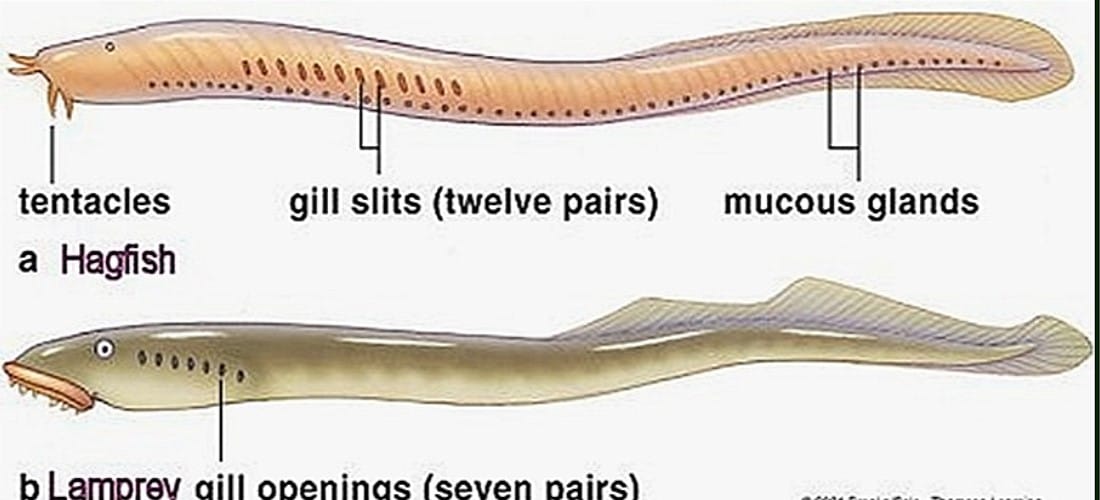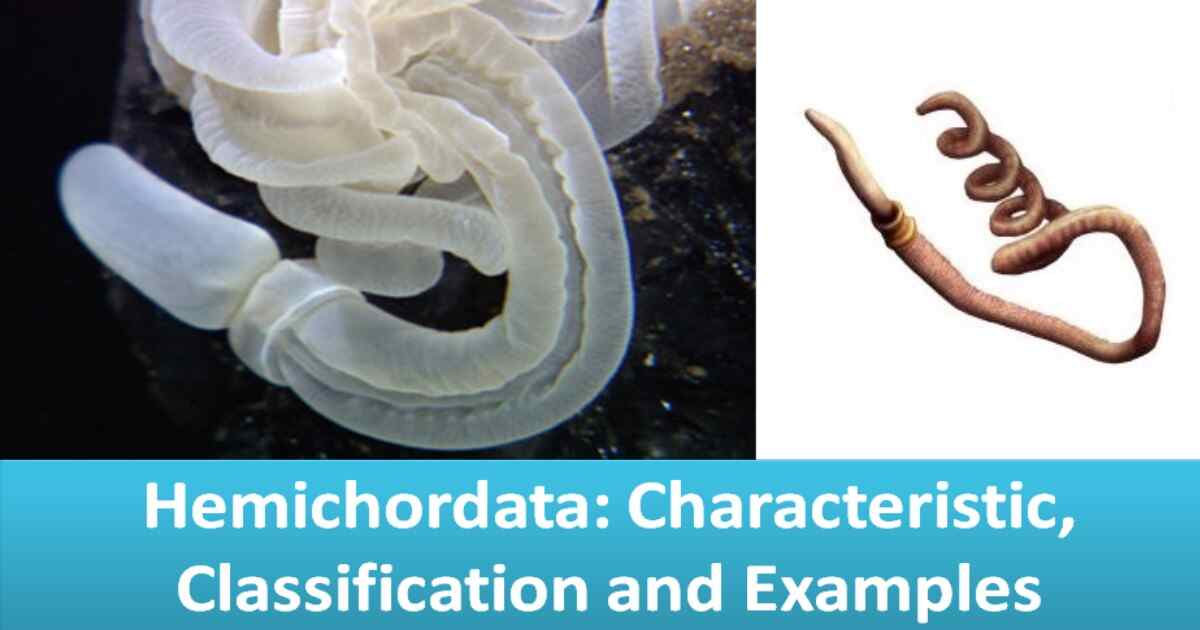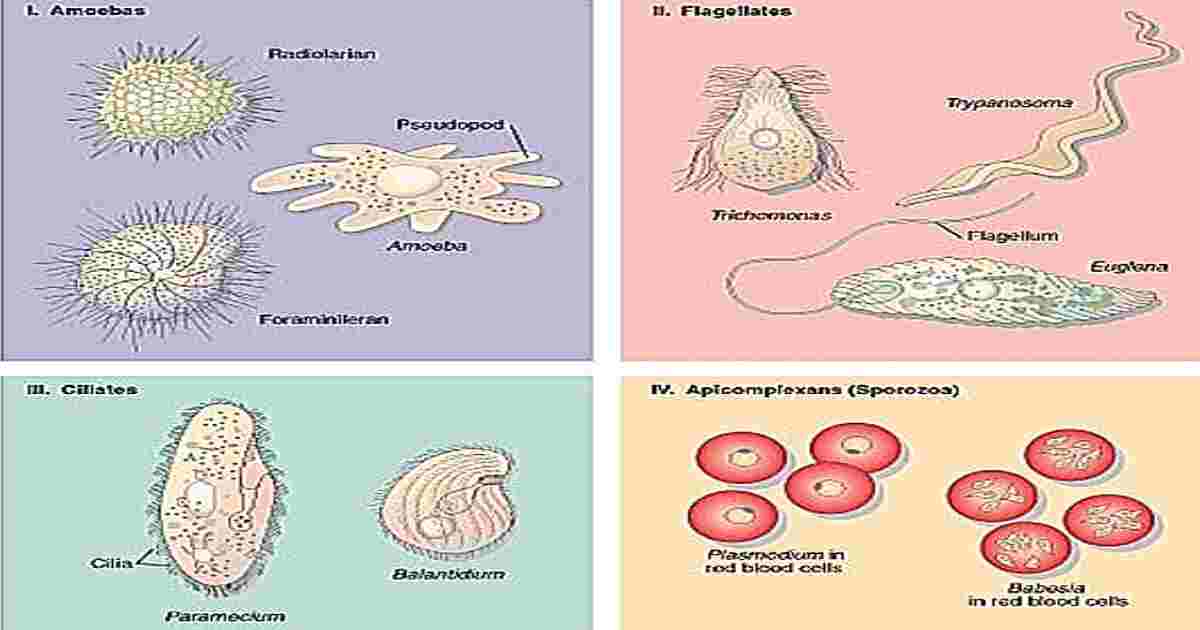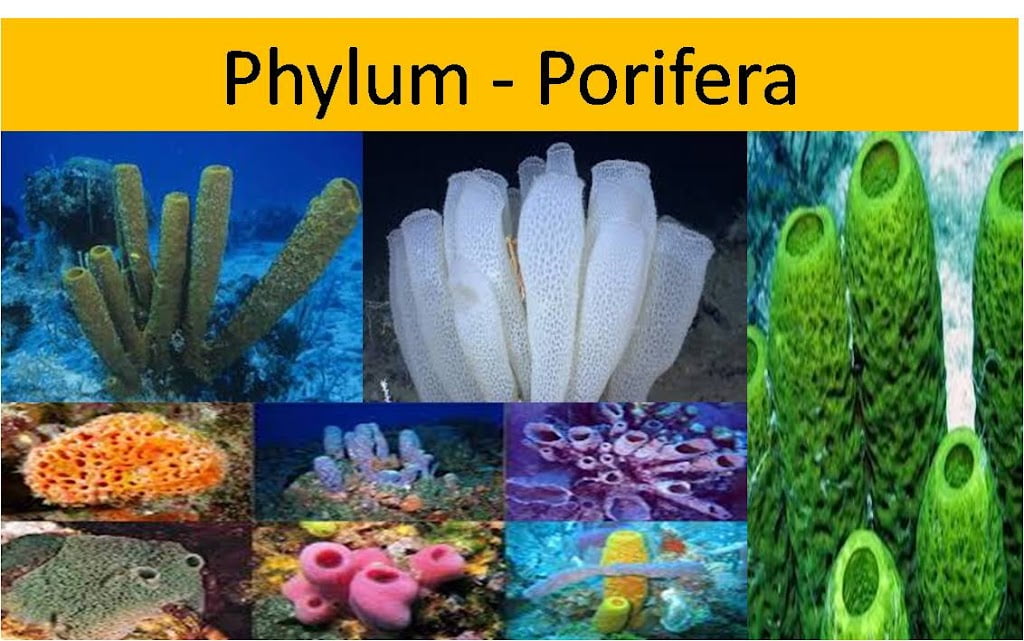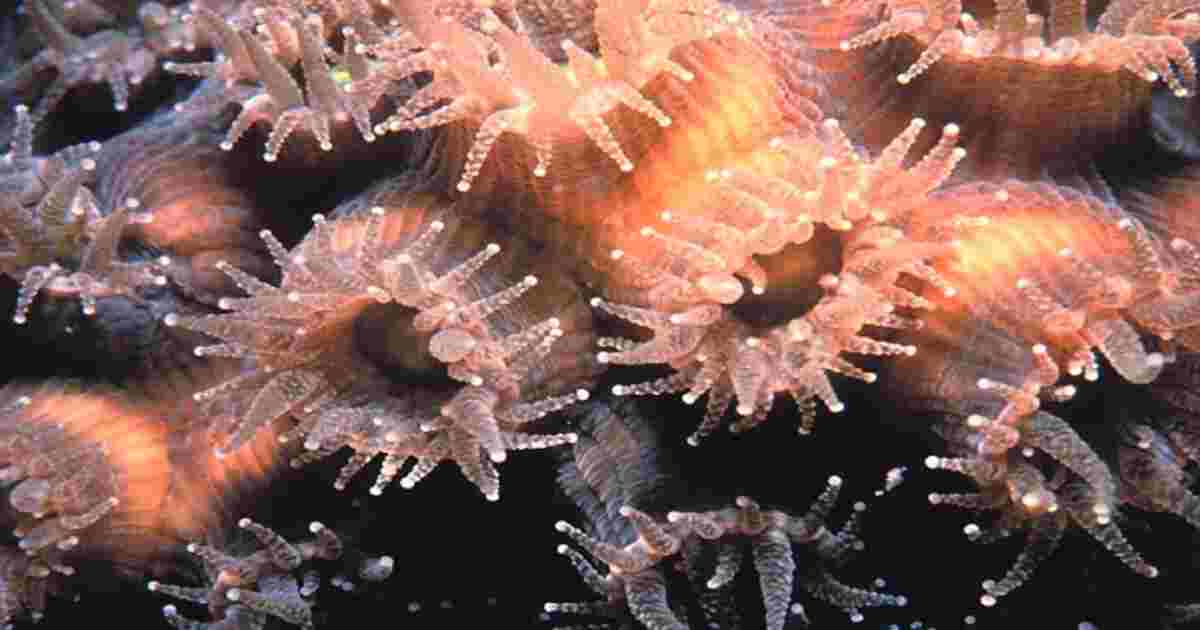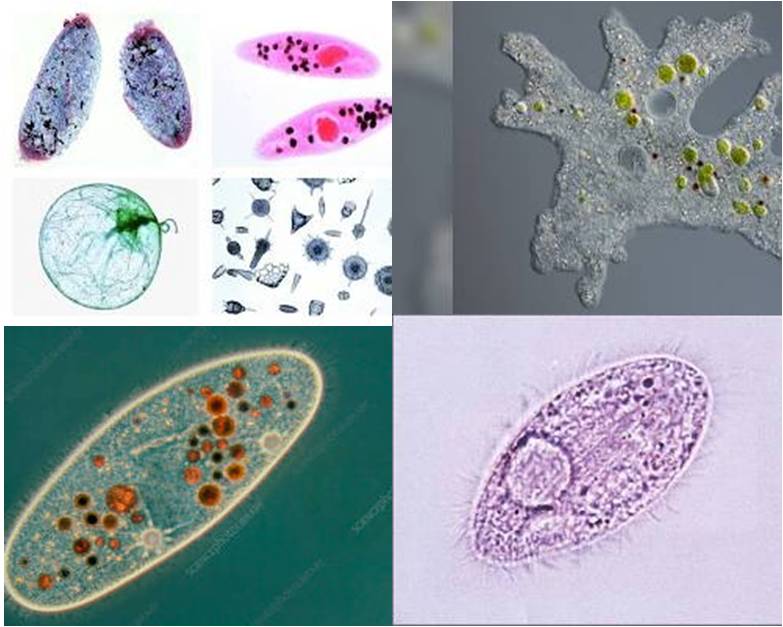Phylum Protozoa: The Phylum Protozoa comprising a diverse group of unicellular organisms. Let’s explore their characteristics and classification.
Defination:
The Protozoa may be defined as ‘microscopic, acellular animalcules existing singly or colonies, without tissues and organs, having one or more nuclei. When in colonies, they differ from Metazoa in having all the individuals alike except those engaged in reproductive activities’.
GENERAL CHARACTERS
- The protozoans are small, generally microscopic animalcules.
- Simplest and primitive of all animals with very simple body organisation, ie., protoplasmic grade of organisation.
- Acellular animals, without tissues and organs.
- Body naked or covered by pellicle but in some forms body is covered with shells and often provided with internal skeleton.
- Protozoans are solitary or colonial; in colonial forms the individuals are alike and independent.
- Body shape variable; it may be spherical, oval, elongated or flattened.
- Body protoplasm is differentiated into an outer ectoplasm and inner endoplasm.
- Protozoans may have one or more nuclei; nuclei may be monomorphic or dimorphic, vesicular or massive. Vesicular nuclei are commonly spherical, oval or biconvex, consist of a central body, the endosome (nucleolus) encircled by a zone of nuclear sap.
- Locomotory organelles are pseudopodia, flagella, cilia or none.
- Nutrition may be holozoic (animal-like), holophytic (plant-like), saprozoic or parasitic Digestion intracellular, takes place inside the food vacuoles.
- Respiration occurs by diffusion through general body surface.
- Excretion also occurs through general body surface but in some forms through a temporary opening in the ectoplasm or through a permanent pore, the cytopyge.
- Contractile vacuoles perform osmoregulation in freshwater forms and also help inremoving excretory products.
- Reproduction asexual or sexual; asexual reproduction occurs by binary fission, multiple fission, budding conjugation. or sporulation and sexual reproduction is performed by gamete formation or
- Life cycle often exhibits alternation of generation, ie., it includes asexual and sexual phases.
- Encystment usually occurs to tide over the unfavourable conditions and it also helps in dispersal.
- The single celled body of Protozoa performs all the vital activities of life and, therefore, no physiological division of labour is exhibited by them.
- The protozoans exhibit mainly two modes of life, free-living inhabiting freshwater, salt water, damp places and ecto and endo parasitic life. They are also commensal in habit.
Classification of Phylum Protozoa with Example
According to Honigberg et.al, (1964) the phylum protozoa have been classified into four subphylum.
SUBPHYLUM I: SARCOMASTIGOPHORA
(Gr. Sarcodes=fleshy; mastix=whip; phoros=bearing)
- The locomotion is done by flagella and pseudopodia.
- Present of monomorphic nucleus.
- They are not formation of spore
- Syngamy occurs in reproduction
- This subphylum is further divided in to 3 super classes:
Superclass 1: Mastigophora (Gr. Mastix=whip; phoros=bearing)
- The body is covered by pellicle.
- The locomotory organelles are flagella.
- Asexual reproduction occurs by longitudinal binary fission.
Class 1: Phytomastigophora (Gr. Phyton=plant; Mastix=whip; phoros=bearing)
- They have chromatophores with chlorophyll.
- The nutrition is mainly holophytic which takes place by phototrophy.
- These are free living organisms.
- The reserve food in the form of starch or paramylon.
- It has one or two flagella.
Examples: Euglena, Ceratium, Noctiluca
Class 2: Zoomastigophora (Gr. Zoon=animal; Mastix=whip; phoros=bearing)
- These organisms do not have chlorophyll-bearing chromatophores.
- These are mostly parasitic.
- The nutrition is holozoic or saprozoic.
- The reserved food is glycogen.
- They may have one or many flagella.
Examples: Leishmania, Trypanosoma, Trichomonas, Trichonympha
Superclass 2: Opalinata
- These live as commensals or parasites in the gut of anurans.
- Their body is covered by oblique rows of cilia-like flagella.
- These organisms may have two or many nuclei also the nuclei are monomorphic.
- They undergo asexual reproduction by binary fission or by syngamy.
- Sexual reproduction takes place by anisogamy.
Examples: Opalina, Zelleriella
Superclass 3: Sarcodina (Gr. Sarcode=fleshy)
- Locomotory organelles are pseudopodia.
- The amoeboid form is predominant.
- Some have a hard shell.
- They generally do not form spores.
- The formation of gametes and flagellated young ones are common.
- Nutrition holozoic or saprozoic.
- This super class is further divided into 3 classes:
Class 1: Rhizopodea (Gr. Zoon=animal; Mastix=whip; phoros=bearing)
- Locomotory organelles are pseudopodia (lobopodian or filopodia but never axopodia)
- Pseudopodia as lobopodian.
- They have tapering and branching filopodia.
- These are mostly free living and a few are also parasitic.
Examples: Amoeba, Entamoeba, Elphidium
Class 2: Piroplasmea
- They are parasitic mode of life.
- Small, round-shaped or amoeboid parasites in vertebrate red blood cells.
- Locomotory organs are absent.
- Spores are also absent.
- These are the small parasites in the red blood cells of vertebrates.
Examples: Babesia
Class 3: Actinopodea (Gr. Actis=ray; podos=foot)
- The pseudopodia in the form of axopodia with axial filaments, radiating from the spherical body.
- These are planktonic.
- This class includes Heliozoans, Radiolarians and acanthareans.
- Radiolarians and acanthareans are marine forms whereas heliozoans are both marine and fresh water forms.
- Skeletons of radiolarians have siliceous shells.
- The shells of dead radiolarians accumulate on the ocean floor to form radiolarian ooze.
Examples: Collozoum, Actinophrys, Acanthometra
SUBPHYLUM II: SPOROZOA
- They are exclusively endoparasites.
- Special locomotory organelles are absent in these animals.
- Sometimes pseudopodia are present which are useful only for ingestion of food. Sporozoites are merozoites bear anterior apical complex that helps penetrate host cells.
- It consisting of three classes:
Class 1: Telosporea
- The Sporozoites are long in these animals.
- Reproduction is both asexual and sexual.
- They are found in blood and gut of vertebrates.
- Sexual reproduction is by isogamy or anisogamy.
Examples: Monocyctis, Eimera, Plasmodium
Class 2: Toxoplasmea
- Asexually reproduction, which takes place by internal budding where two daughter cells are produced within the mother cell.
- The mother cell is finally destroyed in the process of reproduction.
- Spores are absent.
Examples: Toxoplasma
Class 3: Haplosporea
- The spores in this class are amoeboid.
- Reproduction is only asexual type taking place through multiple fissions.
Examples: Haplosporidium, Ichthyosporidium
SUBPHYLUM III: CNIDOSPORA (Gr. Knide=nettle; spora=seed)
- They are parasitic nature.
- Special kinds of locomotory organelles are absent.
- Spores are present with one or more polar filaments.
- Polar filaments are special and unique features.
- When these spores infect a host, the polar filament is discharged and it is attached to the host tissue.
- This subphylum includes 2 classes:
Class 1: Myxosporidea
- The spores are large and develop from several nuclei.
- These are generally extracellular parasites.
- The spores have two polar filaments and have two to three valves
Examples: Myxobolus
Class 2: Microsporidea
- The spores are small and only one nucleus.
- These spores have single valve.
- These are generally intracellular parasites.
- Many species have a single polar filament.
Examples: Nosema bombycis
SUBPHYLUM IV: CILIOPHORA
(La. Cilium=eye lid with lashes; phoros=bearing)
- Ciliophorans are complex of all the protozoans.
- The locomotory is cilia.
- These cilia also help in feeding at some stage of the life cycle.
- The nuclei is dimorphic.
- Macronucleus is vegetative and polyploid.
- Micronucleus is reproductive and diploid.
- Asexual reproduction takes place by binary fission.
- Sexual reproduction takes place by conjugation.
Class 1: Ciliatea
- The locomotory organelles are numerous hair-like cilia.
- One or more contractile vacuoles are present. ‘Phylum Protozoa’
- The nucleus is dimorphic including both macronucleus and micronucleus.
Examples: Paramoecium, Vorticella, Balatidium

